Stool Samples Provide Marker for Bowel Disease
By LabMedica International staff writers
Posted on 08 Apr 2014
A novel method for distinguishing different types of bowel disease using the stool samples of patients has been created which is an ideal noninvasive testing method for the diagnosis of gastro-intestinal diseases. Posted on 08 Apr 2014
The method works by analyzing the chemical compounds emitted from the samples and could provide cheaper, quicker and more accurate diagnoses, at the point of care, for a group of diseases that have up until recently been very hard to differentiate.

Image: The SRI 8610C gas chromatograph (Photo courtesy of SRI Instruments).
Scientists at the University of the West of England (Bristol, UK) obtained 182 stool samples from patients with inflammatory bowel disease (IBD) and irritable bowel syndrome (IBS) between October 2010 and October 2011. IBS samples were obtained from patients with diarrhea predominant (IBS-D), constipation predominant (IBS-C), and the alternating between the two syndrome (IBS-A). IBD samples were obtained from patients with both ulcerative colitis (UC) and Crohn's disease (CD). Control samples were collected from healthy patients.
The test was based on the volatile organic compounds (VOCs) emitted from their stool samples, which act as a proxy for conditions in the gastrointestinal tract and provide a unique profile, or fingerprint, for the different bowel diseases. The investigators developed the method using an SRI 8610C gas chromatograph (SRI Instruments, Torrance, CA, USA) coupled to a metal oxide sensor system with pattern recognition software.
The results showed that patients with IBD could be distinguished from healthy controls with an accuracy of 79%. The method was able to distinguish IBD from IBS with an accuracy of 76%. Differentiating patients with IBS from healthy controls using VOCs appeared to be more difficult and could only be achieved with an accuracy of 54%. The reasons could be because IBS is a functional disorder as opposed to a structural disorder, so the changes in composition of VOCs in the stool samples would not be as great, producing a very similar pattern to healthy controls.
In conclusion, the authors stated that: “Our work has demonstrated that a low-cost device based on VOC analysis could be used to potentially diagnose, and differentiate, IBS and IBD at the point of care. We will continue to study fecal volatiles as a way of detecting IBS, IBD and other gastrointestinal conditions and continue to develop our techniques further. If we're able to produce results that exceed current commercial methods, then our technique could be added to the growing number of medical tests that use VOC analysis as a diagnostic tool.” The study was published on March 27, 2014, in the Journal of Breath Research.
Related Links:
University of the West of England
SRI Instruments













